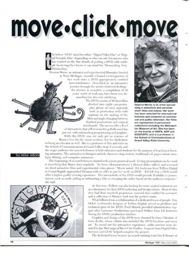Michigan Vue: Vol. 7, No. 3, May/June, 2002, p. 16-17
Michigan VUE Magazine by Mike Allore
The letters “DVD” stand for either “Digital Video Disc” or “Digital Versatile Disc” depending on who you ask, but anyone who has worked on the fine details of putting a DVD with multiple facets together knows it can stand for “Demanding, Very, Demanding.”
Deanna Morse, an animator and experimental filmmaker located in West Michigan recently released a retrospective of her work onto a DVD appropriately entitled MOVE-CLICK-MOVE. Described as “an interactive journey through the artist’s cluttered desktop,” the journey to complete a compilation of 30 years worth of work may have been very demanding but also very satisfying.
The DVD consists of 36 short films divided into eight categories plus plenty of extra materials such as production stills with captions on the making of the films and angle changing between finished productions and original storyboards. The menus offer a level of interactivity that will rival anything Hollywood has put out, with outstanding programming and graphics. With this DVD you not only get an essence of Morse’s love for the visual medium, but her dedication to being an educator as well. She is a professor of film and video in the School of Communications at Grand Valley State University and the target audience for MOVE-CLICK-MOVE is both educators and students for the purpose of teaching or learning animation. The animation techniques include character, stopmotion, traditional cel, paper cutout, time-lapse filming, and computer animation.
The beginnings of MOVE-CLICK-MOVE started with a more practical need. Giving presentations on her work is something that Morse does regularly. “In these {demonstrations} I showed slides, talked and screened my short animation films and experimental video pieces,” Morse noted. Ed Anderson from Trillion Digital in Grand Rapids approached Deanna with an offer to put her work on DVD. “Ed felt that a DVD would offer a higher quality viewing experience. The interactivity of the DVD would provide flexibility in presentations, such as easily adding or subtracting a film or changing the order based on the audience response,” she said.
At that time, Trillion was also looking for some neutral content to use as a showpiece for their DVD authoring and design talents. Most of what they had done involved proprietary material that couldn’t be screened, and a collection of Morse’s work was the perfect venue.
What followed was a collaboration of a dedicated team of people. Eric Oehrl, multimedia designer at Trillion Digital, served as producer and technical guru of the DVD. Fred Munch provided administrative support after Lawrence Productions purchased Trillion from Ed Anderson during the DVD’s production timeline.
Graphics and design of the DVD were donated by Grey Christian of Grey-Berlin, whose efforts also included the DVD brochure and cover art. To round out the interactive experience, audio services were donated by Joe McCargar of River City Studios. Support from Digital Video Services and GVSU helped complete the project.
The dedicated team became an award-winning team this February at the 2002 Addy Awards Show help by the West Michigan Ad Club MOVE-CLICK-MOVE won an Addy in the Industry Self-Promotion, Agency/Design Studio/Freelancers/Graphic Designers - Interactive category. Morse is pleased with all the positive response to the DVD as well. “It’s been well received, which certainly didn’t surprise me, since I think they created a fabulous interface for my films to live in.”
MOVE-CLICK-MOVE is not only a terrific teaching/learning tool; it is also a tribute to the visual arts and belongs in the collections of people who enjoy watching animation. Morse’s work ranges from short pieces that have been broadcast on Sesame Street to “Charleston Home Movie” which has found a permanent home in the Metropolitan Museum of Art in New York City. Many of the pieces included in MOVE-CLICK-MOVE are extremely short in length, yet force the viewer to think and consider. But most of all they serve the instructor’s aim: to inspire and motivate her audience to start animating themselves. Now that’s the ultimate form of interactivity.
Allore, Michael, “move-click-move,” MICHIGAN VUE, Vol. 7, No. 3, May/June, 2002, p. 16-17




